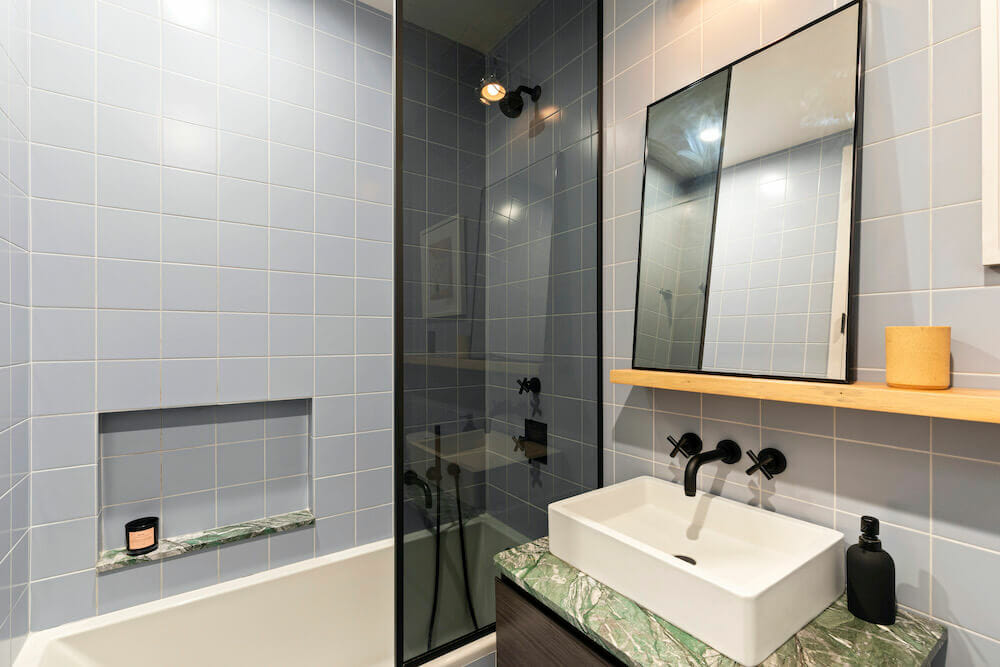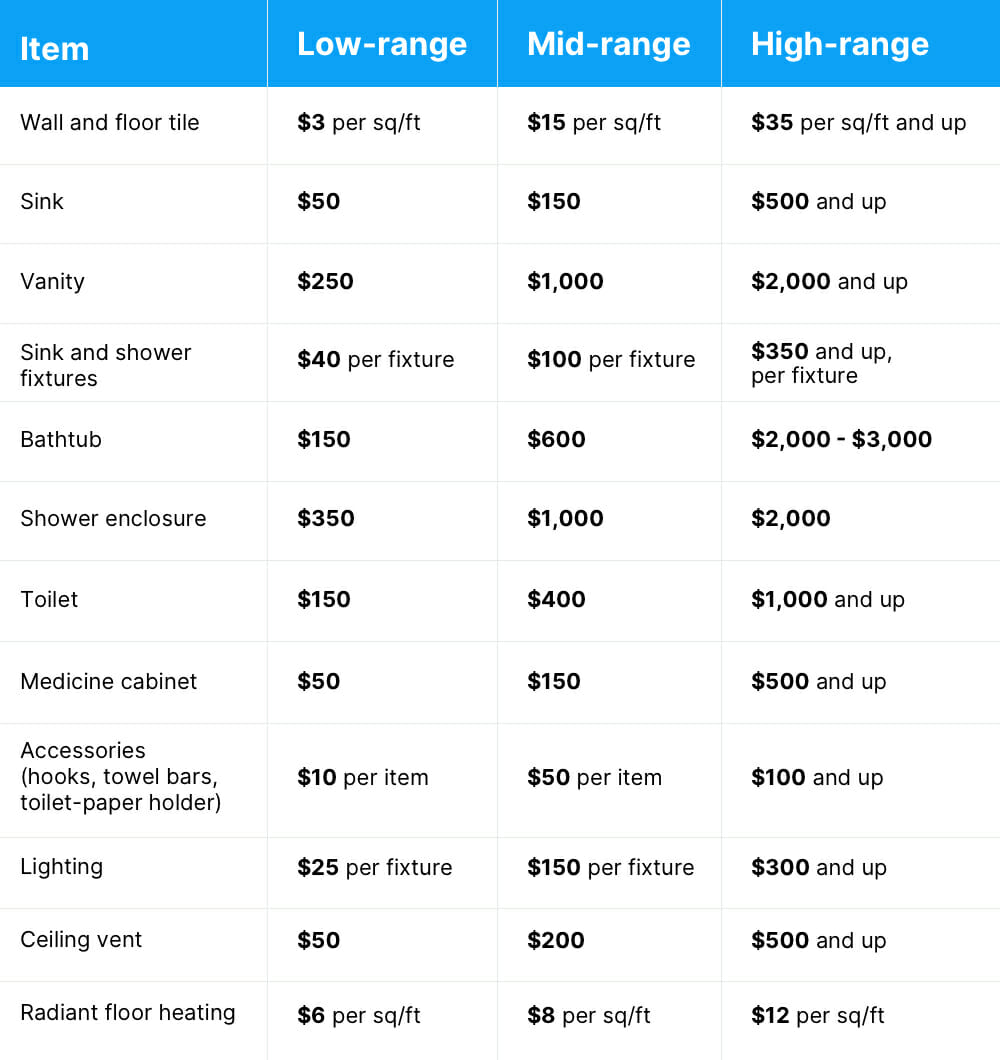2021 Average Bathroom Remodel Cost in New York City
Ready to renovate? Here’s what you’ll need to calculate the cost of a bathroom remodel in NYC, including materials, labor, and permits

(Above) Sweeten homeowner Matthew’s bathroom renovation
With an abundance of Pinterest boards and design blogs, it’s easy to imagine how your dream NYC bathroom could look. If you’re ready to turn those daydreams into reality, the first crucial step is creating a bathroom remodel budget. To get you started, Sweeten offers a roadmap of elements that will impact the cost of a bathroom remodel in New York City. Sweeten’s guide to bathroom remodeling costs, covering building requirements, permits, and design will help nail down your scope and better align real costs with a realistic budget.
Sweeten matches home renovation projects with vetted general contractors, offering advice, support, and up to $50,000 in renovation financial protection—for free.
Take a look at the overall average cost to remodel a bathroom in New York City, based on Sweeten renovations:
- Low-end remodel: Starting at $600 psf (per square feet) or $21,000 (based on a 35-sq-ft space)
- Mid-range remodel: Starting at $700 psf or $24,500 (based on a 35-sq-ft space)
- High-end remodel: Starting at $850 psf or $68,000 (based on a 80-sq-ft space)
Pro tip: Do not wait. The pandemic has caused a backlog in the supply of materials in many sectors. For homeowners interested in renovating, it’s smart to schedule and sign with a contractor to lock in your material prices. You’ll also want to book a start date on the contractor’s schedule. If you do wait, prices will continue to go up and your material order will start at the back of a long queue.
Remodeling an NYC bathroom all at once
While it can be tempting to apply à la carte prices to individual elements of the work, a full bathroom renovation is an integrated process that involves design, materials, installation, and plumbing. If your bathroom has one or two areas of concern, you might decide to swap out an individual fixture or two. You can replace a toilet or vanity or take on some limited retiling and pay solely for the cost of the new fixtures and the hours of installation work.
However, it can be misleading to break up and price out each step of a bathroom remodel. Even if you are just redoing fixtures and tile work, you may discover that you need to replace the sheetrock on the wall or address issues behind the walls, like old valves and ancient drain pipes. A gut renovation, which addresses the whole bathroom space, allows you to plan more broadly. By doing a gut renovation, you can get more work done, in the right sequence, and more cost-effectively.
Low to high-end costs for bathroom materials and finishes
Listed below are the visible parts of a bathroom renovation, and probably the aspect you’ve spent the most time thinking about. Review the range of pricing for various fixtures, materials, and finishes in the chart below. On the low end, you’ll find items sourced from big-box stores like Home Depot, Walmart, or IKEA. Prices increase if you choose to use their interior boxes but upgrade or customize the function or style, such as the door fronts. On the high end are highly customized, handmade, or imported items.
How much will materials for a bathroom remodel cost?
- Wall and floor tile: Low-end – $3 per square foot (psf), Mid-range – $15 psf, High-end – $35 psf
- Sink: Low-end – $50, Mid-range – $150, High-end – $500 and up
- Vanity: Low-end – $250, Mid-range – $1,000, High-end – $2,000 and up
- Sink and shower fixtures: Low-end – $40/fixture, Mid-range – $100/fixture, High-end – $350/fixture
- Bathtub: Low-end – $150, Mid-range – $600, High-end – $2,000 – $3,000
- Shower enclosure: Low-end – $350, Mid-range – $1,000, High-end – $2,000
- Toilet: Low-end – $150, Mid-range – $400, High-end – $1,000 and up
- Medicine cabinet: Low-end – $50, Mid-range – $150, High-end – $500 and up
- Accessories (hooks, towel bar, paper towel holder): Low-end – $10/item, Mid-range – $50/item, High-end – $100 and up
- Lighting: Low-end – $25/fixture, Mid-range – $150/fixture, High-end – $300 and up
- Ceiling vent: Low-end – $50, Mid-range – $200, High-end – $500 and up
- Radiant floor heating: Low-end – $6 psf, Mid-range – $8 psf, High-end – $12 psf

Budget for permits, design, and everything behind-the-scenes
In contrast to visible upgrade items, there are unavoidable behind-the-scenes investments to consider when creating your budget.
1.) Building requirements
For those in apartments, building requirements can play a significant role in dictating design and budget needs. These requirements can range from insurance coverage minimums, which limit your ability to work with professionals who aren’t carrying high-value insurance policies, to general alteration agreements that require anyone doing any work in the building to have far-reaching coverage for problems they may never encounter, like asbestos removal or collapse scenarios.
Sweeten contractor Thomas explained, “Buildings are becoming less flexible on their [insurance] requirements which cause us to raise prices to keep up with those needs.” The contractors who can afford to work in buildings with more extensive requirements tend to have higher operating costs and can meet higher insurance requirements, more stringent debris removal expectations, limited noise and hours-of-work requirements, and stricter parking rules. While there is no exact figure on this, you may see this translate into higher rates overall for teams that can meet those demands.
2.) City permits
- Plumbing services: $2,000 – $3,500 and higher
- Plumbing permits: up to $2,000 and as high as $5,000 per permit
- Electrical permits: $900
- Asbestos inspection: $500 to $1,000
Tackling a bathroom remodel means planning for plumbing services and permits. Any plumbing work that exceeds a minor repair or a direct swap of a similar fixture requires a permit from the City’s Department of Buildings, which can run up to $2,000 and as high as $5,000 per permit. Plumbing is a specialized trade that often comes with hourly rates; expect to budget between $2,000 and $3,500 (or higher) for a full bathroom remodel.
If you’re adding outlets or doing electrical work, an electrical permit may be needed, which can run close to $900. You may also need an asbestos inspection, depending on the building requirements and your plumbing plans, which cost $500 to $1,000.
3.) How design affects bathroom remodel costs
In the design stage, plan to collaborate with the experts you hire to produce detailed drawings that account for all physical elements of the bathroom. A schematic drawing is usually presented to the building board as part of the approval process, which needs to outline the locations of the major fixtures as well as specifications for the vanity and tub/shower, and lighting.
If you plan to move the plumbing to convert a bathtub to a shower or vice versa, the permit alone to change the plumbing in NYC is $6,000. This is because you’ll need to hire a registered architect to file a permit application certifying that the plan complies with applicable codes and laws. An architect or interior designer will typically charge 15 to 20 percent of the project’s construction costs for his or her fee.
Sweeten general contractors can help provide architect referrals for a range of services, saving homeowners a step.
4.) Demolition and site prep
In this stage, labor is needed to ensure that your bathroom renovation maintains its value over time. Old materials and fixtures need to be disposed of, which can be complicated on busy city streets with limited parking. This difficulty will be reflected in the contractor’s rate. Almost without exception, your contractor may need to strip the walls and flooring to frame and level before any installation occurs. This behind-the-scenes step is critical and labor-intensive and can cost an average of $2,000.
If your home is new or the sub-floor is concrete, any leveling needs may be minimal. Otherwise, you probably need to account for floor leveling and new drywall or plastering before any surface work can get going.
Exposing the existing conditions inside walls while leveling and framing will also allow your contractor to address plumbing or electrical issues before you hook up a new plumbing fixture. It may be necessary to replace all horizontal plumbing work to the building’s “stack” (the main vertical lines that run throughout the building) and run new wiring to head off plumbing and electrical problems that you may have unwittingly inherited.
You’ll want to factor in costs that support the success and longevity of the work. Examples of this are prep work to protect floors and valuables (which can add $600 to $900) and waterproofing steps (which can add $1,000). This is critical for the project’s foundation alignment and infrastructure.
WATCH VIDEO:
5.) Installation
Installation is the final stage to incorporate all of the materials you’ve purchased. The craftsmanship involved in the installation of all the pieces will depend on the size of your bathroom and the degree of customization you need to make all of the pieces fit.
PRO TIP: Expect to spend 30 percent or less of your total project cost on visible materials, fixtures, and finishes. The rest will go to behind-the-scenes costs, like labor, permits, and fees.
6.) Behind-the-scenes costs
Costs of raw materials
For 2021, Sweeten general contractors are seeing wood materials as the main increase in costs. “These material costs have increased approximately 3x the amounts mainly due to Covid related issues, from what we have seen,” said Sweeten contractor Thomas. “These, in turn, relate to higher costs for plywood subfloors, kitchen cabinets, and other woodwork-related projects.”
Overhead costs for a bathroom remodel
General contractors always factor in a percentage of the project to cover overhead costs, including insurance, administrative support, and the inevitable costs of growing a business. Sweeten contractors range from two-men crews to much larger entities that employ dozens of staff (including designers, project managers, millworkers and laborers, bookkeepers and operations staff). No matter the size of your contractor’s business, however, you will absorb some of the cost increases they bear from year to year, though not necessarily dollar for dollar.
Sweeten contractor Aaron explained that in the last year, there have been specific increases of compliance, certificates and safety measures imposed on MEP subcontractors (mechanical, electrical, and plumbing) by the Department of Buildings leading to higher costs. While Sweeten contractors attempt to explore all avenues to stay competitive, it is an industry that is affected by trade. The prices you’re quoted at any given time may not be the same six months or a year from now. Prices on labor and materials fluctuate and this will be reflected in your overall quote.
You have a fair amount of choice in deciding what to spend on the material aspects of a bathroom renovation. Less obvious are the costs that are the backbone and labor of the work overall, no matter what you spend on materials. Knowing what impacts cost in a bathroom remodel will allow you to better align your budget while avoiding surprises.
—
Find out how long a bathroom renovation takes—and what’s involved—in our step-by-step guide and process timeline.
Refer your renovating friends to Sweeten and you’ll both receive a $250 Visa gift card when they sign a contract with a Sweeten general contractor.
Sweeten handpicks the best general contractors to match each project’s location, budget, scope, and style. Follow the blog, Sweeten Stories, for renovation ideas and inspiration and when you’re ready to renovate, start your renovation on Sweeten.
source https://civilco.construction/2021-average-bathroom-remodel-cost-in-new-york-city/
Comments
Post a Comment